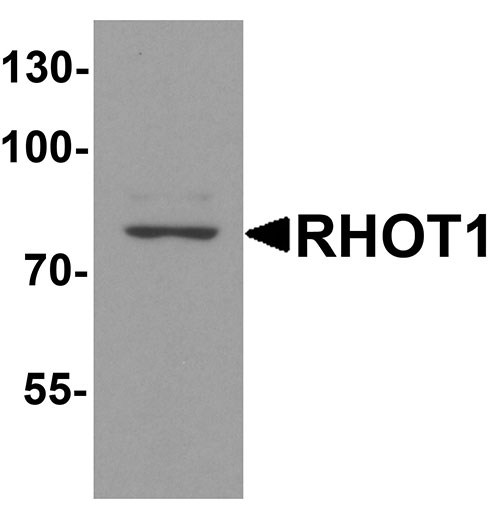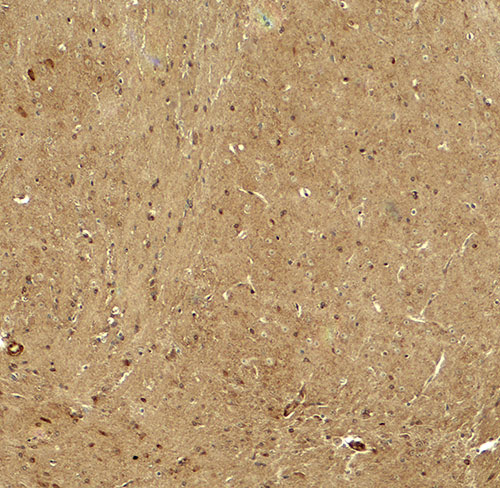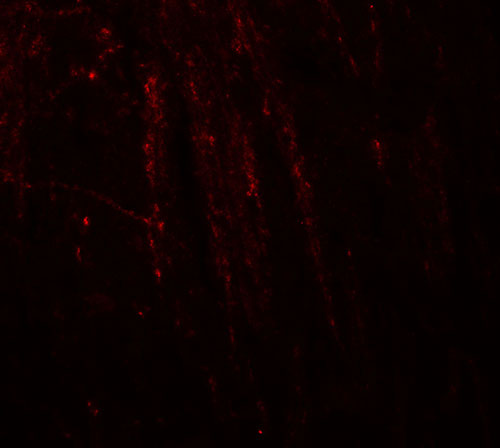RHOT1 Antibody
- SPECIFICATION
- CITATIONS
- PROTOCOLS
- BACKGROUND

Application
| WB, IHC-P, IF, E |
|---|---|
| Primary Accession | Q8IXI2 |
| Other Accession | NP_001028740, 75750480 |
| Reactivity | Human, Mouse, Rat |
| Host | Rabbit |
| Clonality | Polyclonal |
| Isotype | IgG |
| Calculated MW | Predicted: 76 kDa Observed: 78 kDa |
| Application Notes | RHOT1 antibody can be used for detection of RHOT1 by Western blot at 1 - 2 µg/ml. Antibody can also be used for immunohistochemistry starting at 5 µg/mL. For immunofluorescence start at 20 µg/mL. |
| Gene ID | 55288 |
|---|---|
| Target/Specificity | RHOT1; RHOT1 antibody is human, mouse and rat reactive. At least three isoforms of RHOT1 are known to exist; this antibody will detect all three isoforms. |
| Reconstitution & Storage | RHOT1 antibody can be stored at 4℃ for three months and -20℃, stable for up to one year. |
| Precautions | RHOT1 Antibody is for research use only and not for use in diagnostic or therapeutic procedures. |
| Name | RHOT1 |
|---|---|
| Synonyms | ARHT1 |
| Function | Mitochondrial GTPase involved in mitochondrial trafficking (PubMed:12482879, PubMed:16630562, PubMed:22396657). Probably involved in control of anterograde transport of mitochondria and their subcellular distribution (PubMed:12482879, PubMed:16630562, PubMed:22396657). Promotes mitochondrial fission during high calcium conditions (PubMed:27716788). |
| Cellular Location | Mitochondrion outer membrane; Single-pass type IV membrane protein. Note=Colocalizes with MGARP and RHOT2 at the mitochondria |
| Tissue Location | Ubiquitously expressed. Expressed at high level in heart and skeletal muscle. |

Thousands of laboratories across the world have published research that depended on the performance of antibodies from Abcepta to advance their research. Check out links to articles that cite our products in major peer-reviewed journals, organized by research category.
info@abcepta.com, and receive a free "I Love Antibodies" mug.
Provided below are standard protocols that you may find useful for product applications.
Background
The Ras homolog family member T1 (RHOT) is an atypical Rho Ca2+-binding GTPase that localizes to the mitochondria (1). RHOT1, the related protein RHOT2, the adaptor protein Milton, and the PTEN induced putative kinase 1 (PINK1), form a complex that is involved in axonal transport of mitochondria (2,3). Both PINK1 and Parkin target RHOT1 for phosphorylation and degradation, causing the arrest of mitochondrial motility (4).
References
Fransson A, Ruusala A, and Aspenstrom P. Atypical Rho GTPases have roles in mitochondrial homeostasis and apoptosis. J. Biol. Chem. 2003; 278:6495-502.
Macaskill AF, Brickley K, Stephenson FA, et al. GTPase dependent recruitment of Grif-1 by Miro1 regulates mitochondrial trafficking in hippocampal neurons. Mol. Cell. Neurosci. 2009;40:301–12.
Weihofen A, Thomas KJ, Ostaszewski B, et al. Pink1 forms a multi-protein complex with Miro and Milton, linking Pink1 function to mitochondrial trafficking. Biochemistry 2009; 48:2045-54.
Wang X, Winter D, Ashrafi G, et al. PINK1 and Parkin target Miro for phosphorylation and degradation to arrest mitochondrial motility. Cell 2011; 147:893-906.
If you have used an Abcepta product and would like to share how it has performed, please click on the "Submit Review" button and provide the requested information. Our staff will examine and post your review and contact you if needed.
If you have any additional inquiries please email technical services at tech@abcepta.com.













 Foundational characteristics of cancer include proliferation, angiogenesis, migration, evasion of apoptosis, and cellular immortality. Find key markers for these cellular processes and antibodies to detect them.
Foundational characteristics of cancer include proliferation, angiogenesis, migration, evasion of apoptosis, and cellular immortality. Find key markers for these cellular processes and antibodies to detect them. The SUMOplot™ Analysis Program predicts and scores sumoylation sites in your protein. SUMOylation is a post-translational modification involved in various cellular processes, such as nuclear-cytosolic transport, transcriptional regulation, apoptosis, protein stability, response to stress, and progression through the cell cycle.
The SUMOplot™ Analysis Program predicts and scores sumoylation sites in your protein. SUMOylation is a post-translational modification involved in various cellular processes, such as nuclear-cytosolic transport, transcriptional regulation, apoptosis, protein stability, response to stress, and progression through the cell cycle. The Autophagy Receptor Motif Plotter predicts and scores autophagy receptor binding sites in your protein. Identifying proteins connected to this pathway is critical to understanding the role of autophagy in physiological as well as pathological processes such as development, differentiation, neurodegenerative diseases, stress, infection, and cancer.
The Autophagy Receptor Motif Plotter predicts and scores autophagy receptor binding sites in your protein. Identifying proteins connected to this pathway is critical to understanding the role of autophagy in physiological as well as pathological processes such as development, differentiation, neurodegenerative diseases, stress, infection, and cancer.




